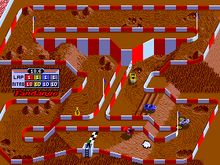
Marble Madness is an arcade video game designed by Mark Cerny and published by Atari Games in 1984. It is a platform game in which the player must guide a marble through six courses, populated with obstacles and enemies, within a time limit. The player controls the marble by using a trackball. Marble Madness is known for using innovative game technologies: it was Atari's first to use the Atari System 1 hardware, the first to be programmed in the C programming language, and one of the first to use true stereo sound.

Ms. Pac-Man is a 1982 maze arcade video game developed by General Computer Corporation and published by Midway. It is the first sequel to Pac-Man (1980) and the first entry in the series to not be made by Namco. Controlling the title character, Pac-Man's wife, the player is tasked with eating all of the pellets in an enclosed maze while avoiding four colored ghosts. Eating the larger "power pellets" lets the player eat the ghosts, who turn blue and flee.

Rampart is a 1990 video game released by Atari Games and Midway Games that combines the shoot 'em up, strategy, and puzzle genres. It debuted as an arcade game with trackball controls, and was ported to home systems. It had a limited US release in October 1990, and a wide release in early 1991. It was distributed in Japan by Namco.
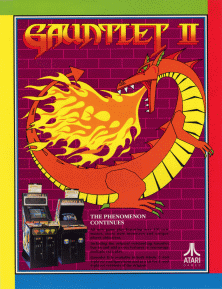
Gauntlet II is a 1986 arcade game produced by Atari Games that serves as the immediate sequel to the original Gauntlet, which was released the previous year. Like its predecessor, Gauntlet II is a fantasy-themed top down dungeon crawler game and was released as a dedicated cabinet, as well as a conversion kit, both available in 2-player and 4-player versions.

Smash TV is a 1990 arcade video game created by Eugene Jarvis and Mark Turmell for Williams Electronics Games. It is a twin-stick shooter in the same vein as 1982's Robotron: 2084, which was also co-created by Jarvis. The Super Nintendo Entertainment System, Genesis, Master System, and Game Gear versions are titled Super Smash TV.
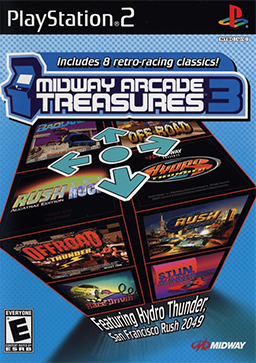
Midway Arcade Treasures 3 is the third and final compilation of classic arcade games published by Midway for the GameCube, PlayStation 2, and Xbox. This compilation includes 8 racing games that were not in the 2003 and 2004 releases Midway Arcade Treasures and Midway Arcade Treasures 2. Like the first and second installments, however, the Xbox version is not compatible with the Xbox 360. Unlike the other installments in the Midway Arcade Treasures series, it is rated E for Everyone by the ESRB. It also differs from the other installments by focusing on one specific genre, while the first two featured games from a wide variety of genres.

Krusty's Fun House is a puzzle video game based on the animated sitcom The Simpsons.

Pit-Fighter is a fighting game developed by Atari Games and released as an arcade video game in 1990. It was Atari's first fighting game. The Japanese release was published by Konami. Home versions were published by Tengen.

Total Carnage is a multidirectional shooter arcade video game originally developed and published by Midway in North America in January 1992. Set in the fictional country of Kookistan during 1999, players assume the role of Captain Carnage and Major Mayhem from the Doomsday Squad in a last-ditch effort to overthrow dictator General Akhboob and his army of mutants from conquering the world, while also rescuing POWs held by his military force.

Terminator 2: Judgment Day or T2 is a light gun shooter based on the film of the same name, produced by Midway Manufacturing Company as an arcade video game in 1991. Developed in tandem with the movie, several actors from the film reprise their roles for the game and are featured as part of the game's photorealistic digitized graphics. The game's plot largely follows that of the film, casting up to two players as the T-800 "terminator" cyborg from the film, sent back in time to protect John Connor from assassination by the T-1000 terminator. A success in arcades, home conversions of the game were released by Acclaim Entertainment for various platforms under the title of T2: The Arcade Game to avoid confusion with the numerous tie-in games also based on the movie.

Double Dragon is a 1987 beat 'em up video game developed by Technōs Japan and distributed by Taito for arcades across Asia, North America and Europe. It is the first title in the Double Dragon franchise. The game's development was led by Yoshihisa Kishimoto, and it is a spiritual and technological successor to Technos' earlier beat 'em up, Nekketsu Kōha Kunio-kun (1986), released outside of Japan by Taito as Renegade; Kishimoto originally envisioned it as a direct sequel and part of the Kunio-kun series, before making it a new game with a different cast and setting.

Lethal Weapon is a video game based on the film series of the same name created by Shane Black. It was developed by Ocean Software and Eurocom and released in 1992 and 1993 by Ocean and Nintendo. It was released in conjunction with Lethal Weapon 3, the third installment of the series.

RoboCop 3 is a video game based on the 1993 film of the same name. Amiga, Atari ST and DOS versions were developed by Digital Image Design beginning in September 1990, and published by Ocean Software in December 1991. The Digital Image Design version includes multiple gameplay styles. During 1992 and 1993, other versions consisting of side-scrolling platform gameplay were released for the Commodore 64, ZX Spectrum, NES, Super NES, Game Gear, Master System, and Sega Genesis.
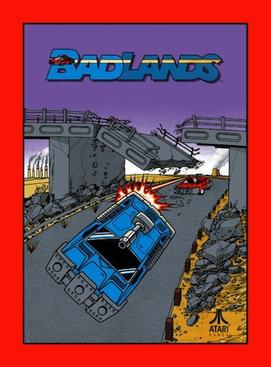
Badlands is a 1989 arcade video game published by Atari Games. It was ported by Domark under the Tengen label to the Amiga, Amstrad CPC, Atari ST, Commodore 64, and ZX Spectrum. The game is a re-themed version of Atari's previous racing games Super Sprint and Championship Sprint with the addition of vehicular combat. Badlands is set in the aftermath of a nuclear war and races around abandoned wastelands with many hazards. Three gun-equipped cars race around a track to win prizes.
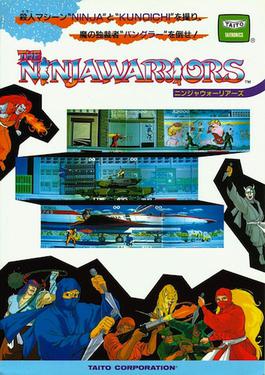
The Ninja Warriors (ニンジャウォーリアーズ) is a side-scrolling beat 'em up video game developed and released by Taito in 1987. The original arcade game situated one display in between projected images of two other displays, creating the appearance of a triple-wide screen. Ports were released for home systems including the Amiga, Atari ST, ZX Spectrum, Commodore 64, Amstrad CPC, PC Engine, and Sega Mega-CD.

Xybots is a 1987 third-person shooter arcade game by Atari Games. In Xybots, up to two players control "Major Rock Hardy" and "Captain Ace Gunn", who must travel through a 3D maze and fight against a series of robots known as the Xybots whose mission is to destroy all mankind. The game features a split screen display showing the gameplay on the bottom half of the screen and information on player status and the current level on the top half. Designed by Ed Logg, it was originally conceived as a sequel to his previous title, Gauntlet. The game was well received, with reviewers lauding the game's various features, particularly the cooperative multiplayer aspect. Despite this, it was met with limited financial success, which has been attributed to its unique control scheme that involves rotating the joystick to turn the player character.

Off Road Challenge is a video game developed and published by Midway. The game was originally released in 1997 for arcades using the Midway V Unit hardware. It is part of the Off Road series which began with Ivan 'Ironman' Stewart's Super Off Road.

Silkworm is a horizontally scrolling shooter developed by Tecmo and first released for arcades in 1988. In 1989 it was ported to the Amiga, Atari ST, Commodore 64, ZX Spectrum, Amstrad CPC and NES (1990) systems by The Sales Curve and released by Virgin Mastertronic.

Danny Sullivan's Indy Heat is a 1991 racing game developed and published in arcades by Leland Corporation. It stars American IndyCar driver Danny Sullivan, and features the tracks of the CART series of the early 1990s. Home versions of the game were released for the Nintendo Entertainment System, Amiga, Atari ST, and Commodore 64.

Road Riot 4WD is an arcade racing game developed by Atari Games and originally released in 1991. In the game, players control weapon-equipped dune buggies and attempt to win races around the globe. A port of the game was released for the Super NES. Versions of the game for the Atari Lynx and Sega Genesis were developed, but never released. A sequel entitled Road Riot's Revenge was also in development and cabinets for the game were made, but the sequel never entered mass production.

